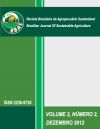PRODUCTION OF JAPANESE TYPE CUCUMBER IN PROTECTED CULTIVATION AS A FUNCTION OF ORGANIC FERTILIZATION
DOI:
https://doi.org/10.21206/rbas.v2i2.168Abstract
The cultivation of cucumber in greenhouse provides better conditions for plant growth, better fruit quality and lower incidence of disease, especially with the use of organic farming techniques. This study aimed to evaluate the productivity of Japanese cucumber cultivar Natsuno Kagayaki, grown in organic systems, with levels of manure and earthworm compost. The experiment was conducted in a greenhouse in the Agricultural Research Company of Minas Gerais - EPAMIG in Viçosa (MG) in the period from 09/01/2010 to 12/09/2010. The experiment was analyzed as randomized blocks design with four replications, with control (no organic manure), six levels of manure and six doses of earthworm castings, totaling 13 treatments. The cucumber plants were planted in plastic pots containing twelve pounds of soil. The fertilizer levels were 0, 60, 120, 240, 480, 720 and 960 g/pot, 100% applied at planting. It was evaluated foliar nutrients, SPAD index, plant height at first harvest, numbers of leaf nodes on the main stem of the plant, diameter, length, mass and fruit number. The highest yield obtained in the manure was 1660.15 grams/plant at a dose of 570 g/pot. The earthworm castings showed an average yield of 903.93 grams/plant, with no significant differences between the doses used.Downloads
Downloads
Published
2012-12-01
How to Cite
Maria Aparecida Nogueira Sediyama, Jefferson Luiz Marciano do Nascimento, Marlei Rosa dos Santos, Sanzio Mollica Vidigal, & Iza Paula Lopes de Carvalho. (2012). PRODUCTION OF JAPANESE TYPE CUCUMBER IN PROTECTED CULTIVATION AS A FUNCTION OF ORGANIC FERTILIZATION. Brazilian Journal of Sustainable Agriculture, 2(2). https://doi.org/10.21206/rbas.v2i2.168
Issue
Section
Artigos
License
1. Proposta de Política para Periódicos de Acesso Livre
Autores que publicam nesta revista concordam com os seguintes termos:
Autores mantém os direitos autorais e concedem à revista o direito de primeira publicação, com o trabalho simultaneamente licenciado sob a Licença Creative Commons Attribution que permite o compartilhamento do trabalho com reconhecimento da autoria e publicação inicial nesta revista.











